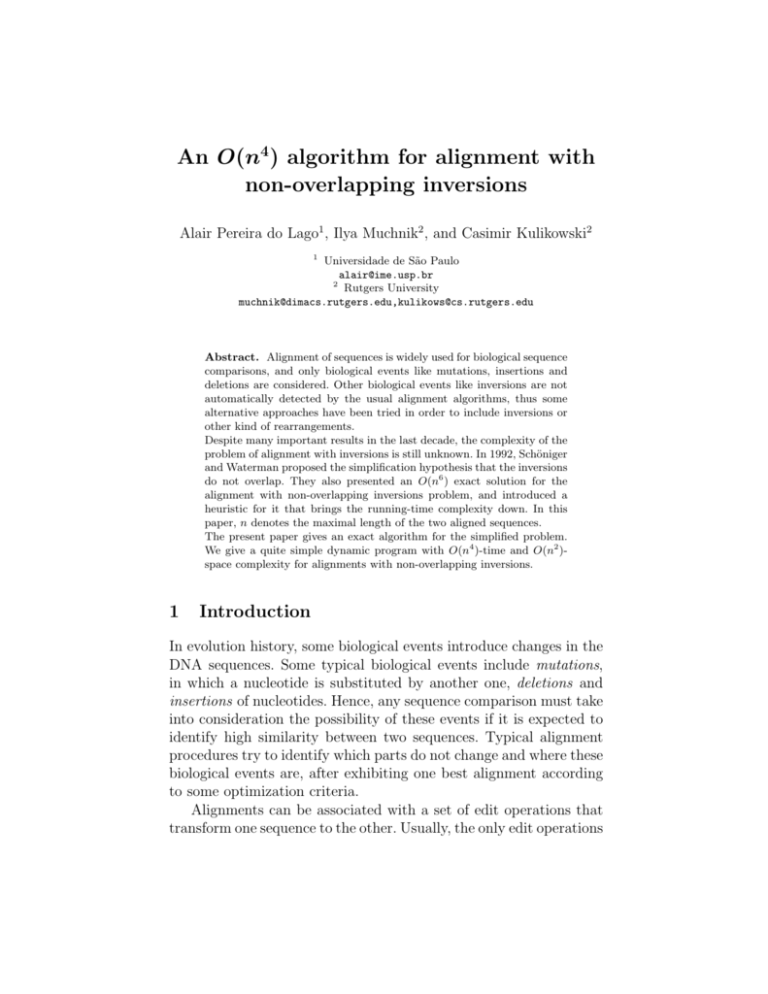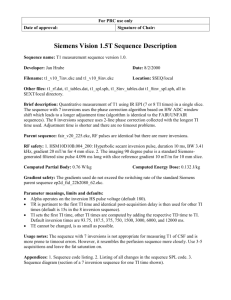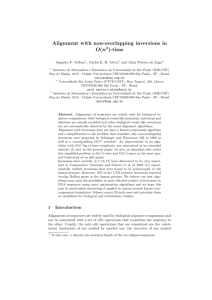A sparse dynamic programming algorithm for alignment with non
advertisement

An O(n4) algorithm for alignment with
non-overlapping inversions
Alair Pereira do Lago1 , Ilya Muchnik2 , and Casimir Kulikowski2
1
Universidade de São Paulo
alair@ime.usp.br
2
Rutgers University
muchnik@dimacs.rutgers.edu,kulikows@cs.rutgers.edu
Abstract. Alignment of sequences is widely used for biological sequence
comparisons, and only biological events like mutations, insertions and
deletions are considered. Other biological events like inversions are not
automatically detected by the usual alignment algorithms, thus some
alternative approaches have been tried in order to include inversions or
other kind of rearrangements.
Despite many important results in the last decade, the complexity of the
problem of alignment with inversions is still unknown. In 1992, Schöniger
and Waterman proposed the simplification hypothesis that the inversions
do not overlap. They also presented an O(n6 ) exact solution for the
alignment with non-overlapping inversions problem, and introduced a
heuristic for it that brings the running-time complexity down. In this
paper, n denotes the maximal length of the two aligned sequences.
The present paper gives an exact algorithm for the simplified problem.
We give a quite simple dynamic program with O(n4 )-time and O(n2 )space complexity for alignments with non-overlapping inversions.
1
Introduction
In evolution history, some biological events introduce changes in the
DNA sequences. Some typical biological events include mutations,
in which a nucleotide is substituted by another one, deletions and
insertions of nucleotides. Hence, any sequence comparison must take
into consideration the possibility of these events if it is expected to
identify high similarity between two sequences. Typical alignment
procedures try to identify which parts do not change and where these
biological events are, after exhibiting one best alignment according
to some optimization criteria.
Alignments can be associated with a set of edit operations that
transform one sequence to the other. Usually, the only edit operations
that are considered are the substitution (mutation) of one symbol
by another one, the insertion of one symbol and deletion of one
symbol. If costs are associated with each operation, there is a classic
O(n2 ) dynamic program that computes a set of edit operations with
minimal total cost and exhibit the associated alignment, which has
good quality and high likelihood for realistic costs.
Consider three new possible edit operations:
– the 2-reversion, which reverses the order of two consecutive symbols;
– the reversion operation, which reverses the order of any segment
of symbols instead of a segment of length 2;
– the inversion operation, which substitutes any segment by its
reverse complement sequence. The inversion operation is the operation that is interesting in molecular biology.
Associated with any of these three operations, we can define new
alignment problems. For instance, given two sequences and fixed
costs for each kind of edit operation, the alignment with inversions
problem is an optimization problem that queries the minimal total cost of an edit operations set that transforms one sequence to
the other. Moreover, one may also be interested in the exhibition
of its correspondent alignment and/or edit operations. Similarly, we
can define the alignment with 2-reversions and the alignment with
reversions problems.
In 1975, Wagner [1] studied the alignment with 2-reversions problem and proved that it admits a polynomial solution if the cost of
2-reversion is null. On the other hand, he also proved that the obtainment of an optimal solution is NP-hard, if any operation has a
constant positive cost.
To the best of our knowledge, the computational complexities of
alignment with reversions and alignment with inversions problems
are unknown.
In order to deal with alignments with inversions, three main approaches have been considered through the years:
– non-overlapping inversions [2];
– sorting unsigned permutations by reversals [3,4] and;
– sorting signed permutations by reversals [5,6,7].
In 1992, Schöniger and Waterman [2] introduced a simplification
hypothesis: all regions involving the inversions do not overlap. This
led to the alignment with non-overlapping inversions problem. They
presented a O(n6 ) solution for this problem and also introduced a
heuristic for it that reduced the running-time. This heuristic uses the
algorithm by Waterman and Eggert [8] that reports the K best non
mutual intersecting local alignments in order to reduce the running
time to something between O(n2 ) and O(n4 ), depending on the data.
The other two approaches apply well for alignment of sequences
of genes and have been very used with mitochondrial genomes. It
does not apply for sequences of nucleotides nor for sequences of
aminoacids because no repetitions of symbols are allowed. (Repeated
genes and paralogs are not allowed.) Moreover, no insertion and
no deletion are considered and the only admitted operation is the
reversal, where a reversal is defined to transform a sequence like
(1, 2, 3, 4, 5) into (1, 4, 3, 2, 5) ((1, −4, −3, −2, 5) in the signed version).
This paper gives an algorithm for the alignment with non-overlapping inversions problem, which is the first approach. Algorithm 1
is a O(n4 ) solution that uses O(n2 ) space.
2
Basic Definitions
Let A be any alphabet, a set of letters. Any finite sequence on A is
also called a word on A or simply a word if the alphabet is clear. Let
A∗ be the set of all words on A, including the empty word denoted
by 1. We identify words of length 1 to the letters they contain. The
concatenation · of words is an associative operation defined over A∗
and it will be often omitted. Let w = w1 w2 . . . wk be a word. We
denote by |w| the length k of w. We will also denote wi , the i-th
letter of w, by w[i]. Let x, y, z ∈ A∗ . We denote by xA∗ the set
{xy | y ∈ A∗ }, we denote by A∗ x the set {yx | y ∈ A∗ } and we
denote by A∗ xA∗ the set {yxz | y, z ∈ A∗ }. We say that x is a prefix
of w if w ∈ xA∗ , we say that x is a suffix of w if y ∈ A∗ x and we say
that x is a factor of w if w ∈ A∗ xA∗ . For 1 ≤ i ≤ j ≤ k, the factor
wi wi+1 · · · wj of w is also represented by w[i . . j].
Let , also called inversion, be any operation on A∗ that satisfies
the following properties:
1. a ∈ A, ∀a ∈ A
2. x · y = y · x, ∀x, y ∈ A∗
Notice that the inversion operation on A∗ is defined by its values on
the letters of A. For instance, let A = {a, c, t, g} and let s ∈ A∗ be
any DNA sequence. If the inversion is defined by a = a, t = t, c = c
and g = g, it maps s to its reverse sequence. On the other hand, if
the inversion is defined by a = t, t = a, c = g and g = c, it maps s
to its reverse complement sequence. Last case is the interesting case
for DNA sequences in molecular biology.
Let ω : A × A −→ R ∪ {−∞} be any weight function. We say
that (a, b) ∈ A × A is a match if ω(a, b) 6= −∞.
Let s = s1 s2 · · · sk and t = t1 t2 · · · tk0 be two words. We define
the matching graph of s and t as the weighted and colored bipartite
graph G = G(s, t, ω, ) = (V, E). The vertex set is a set of symbols
V = {s1 , . . . , sk , t1 , . . . , tk0 } and has size |s| + |t|. (We do not identify
two symbols si and tj even in the case the letters si and tj are the
same letter in A.) The edge set E is a double copy of K|s|,|t| : for any
pair of vertices si and tj we link them with one blue/dark-gray edge
of weight ω(si , tj ) and one red/light-gray edge of weight ω(si , tj ). (In
fact, edges with weight −∞ will not be used for our purposes and
could be deleted.) An edge with weight that is not −∞ is called a
direct match if it is blue and it is called inverted match if it is red.
In Figure 1 we have an example of a matching graph. In this figure,
as in others, we do not draw edges with weight −∞.
s1 s2 s3 s4 s5 s6 s7 s8 s9 s10
t1 t2 t3 t4 t5 t6 t7 t8 t9 t10 t11
Fig. 1. Example of a matching graph
Given u ∈ V ∗ a nonempty factor of s1 s2 · · · sk and v ∈ V ∗ a
nonempty factor of t1 t2 · · · tk0 , we call B = (u, v) a block. Given a
block B = (u, v), there exist integers 1 ≤ i0 ≤ i ≤ |s| and 1 ≤
j 0 ≤ j ≤ |t| such that u = s[i0 . . i] and t = t[j 0 . . j]. Hence, we can
associate ([i0 . . i]×[j 0 . . j]), the rectangle associated with the block B.
Consider an edge that links si to tj and an edge that links si0 to
0
tj . We say that they cross each other if (i − i0 )(j − j 0 ) < 0, we say
that they touch each other if (i − i0 )(j − j 0 ) = 0 and we say that
they are parallel if (i − i0 )(j − j 0 ) > 0. Let M ⊆ E be any set of
edges in a matching graph. Recall that M is called a matching if any
two edges of M do not touch each other. Moreover, M is called a
direct matching if it has only direct matches and any two of them
are parallel. Furthermore, M is called an inverted matching if it has
only inverted matches and any two of them cross each other. The
restriction of M to a block B = (s[i0 . . i], t[j 0 . . j]) is the submatching
of all edges of M with vertices in s[i0 . . i] and t[j 0 . . j]). Finally, M
is called a blockwise inverted matching, or simply a bimatching, if,
considering words in V ∗ ,
– there is l ≥ 1;
– there are l blocks Bi = (ui , vi ) such that s = s1 s2 . . . sk =
u1 u2 . . . ul and t = t1 t2 . . . tk0 = v1 v2 . . . vl ;
– for any i ∈ {1, . . . , l}, the restriction Mi of M to the block Bi is
either a direct matching or an inverted matching;
– M = ∪li=1 Mi .
Given a bimatching M , the number of blocks l is not unique since any
direct submatching Mi can also be split as a union of smaller direct
submatchings. However, the number of blocks such that the corresponding restriction Mi is an inverted matching does not change.
This is the number of inversions of M , ι(M ). Given a bimatching
M , the smallest possible value for l is called the number of blocks of
M.
One can notice that in Figure 2 we have a bimatching M with
four blocks. There are ι(M ) = 2 maximal inverted submatchings.
3
The Algorithm for Optimal Bimatching
Given a bimatching M , one can easily deduce an alignment with nonoverlapping inversions associated with it. One could naturally define
the weight of a matching in a matching graph to be the sum of the
weights of its edges. However, it is quite common for alignments
s1 s2 s3 s4 s5 s6 s7 s8 s9 s10
t1 t2 t3 t4 t5 t6 t7 t8 t9 t10 t11
Fig. 2. Example of a bimatching with four blocks
the establishment of penalties for biological events like mutations,
insertions or deletions. In order to be more general, we attribute a
inversion penalty I ≥ 0 for every inverted submatching Mi . Hence,
we define the weight of a bimatching M as
ω(M ) =
X
ω(e) − ι(M )I.
e∈M
Hence, the following problem is the optimization problem we are
interested in solving.
Problem 1. Given a matching graph G = G(s, t, ω, ), we want to
compute the maximal weight ω(M ) for all possible bimatchings M .
As usual, we may also be interested in a bimatching of maximal
weight.
Such a bimatching M ∗ of maximal weight is called an optimal
bimatching of s and t and its weight ω(M ∗ ) is denoted by BIM(s, t).
The weight of an optimal direct matching is denoted by DM(s, t).
Next lemma leads us to the dynamic programming algorithm
given by Algorithm 1.
Lemma 1. Let A be an alphabet, let a, b ∈ A be any letters, let
u, v ∈ A∗ be any words on A, let us give an inversion operation on
on A∗ and a weight function ω and let I be an inversion penalty.
Hence, the following affirmatives are true:
1. BIM(1, v) = BIM(u, 1) = 0;
BIM(u, v) + ω(a, b)
BIM(ua, v)
2. BIM(ua, vb) = max
BIM(u, vb)
B−I
where B = max{BIM(u1 , v1 ) + DM(u2 , v2 ) | ua = u1 u2 , vb =
v1 v2 , u2 v2 6= 1}.
(Complete proofs are omitted in this paper due to space constraints. The three first cases in the computation of BIM(ua, vb) in
last lemma correspond to the usual dynamic programming analysis
where no inversions are considered. The case B −I consider the cases
where the restrictions of the bimatchings to the blocks (u2 , v2 ) is an
inverted matching.)
Algorithm 1 A O(n4 )-time and O(n2 )-space algorithm for BIM
BIM(s, t)
1 . Compute the table B[i, j] = BIM(s[1 . . i], t[1 . . j])
2 Let B[i, j] be 0 for i = 0 or j = 0
3 for i from 1 to |s| do
4
for j from |t| downto 1 do
5
B[i, j] ← −∞
6
for j from 1 to |t| do
7
B[i, j] ← max(B[i, j], B[i − 1, j], B[i, j − 1])
8
B[i, j] ← max(B[i, j], B[i − 1, j − 1] + ω(s[i], t[j]))
9
. Compute L[i0 , j 0 ] = DM(s[i0 . . i], t[j..j 0 ]) and set B[i, j 0 ]
10
Let L[i0 , j 0 ] be 0 for i0 = i + 1 or j 0 = j − 1
11
for j 0 from j to |t| do
12
for i0 from i downto 1 do
13
L[i0 , j 0 ] ← max(L[i0 , j 0 − 1], L[i0 + 1, j 0 ])
14
L[i0 , j 0 ] ← max(L[i0 + 1, j 0 − 1] + ω(s[i0 ], t[j 0 ]), L[i0 , j 0 ])
15
B[i, j 0 ] ← max(B[i, j 0 ], L[i0 , j 0 ] + B[i0 − 1, j − 1] − I)
16 return B
Algorithm 1 computes BIM(s, t) the maximal weight of a bimatching with time complexity |s|2 |t|2 and space complexity |s||t|.
As usual, by tracking any maximality choice, one can obtain also an
optimal bimatching. The numbers present in positions (si , tj ) of the
incidence matrix of Figure 3(a) show the corresponding values B[i, j]
computed for most important cells in Algorithm 1 if all matches have
weight 1. Hence, one can obtain the bimatching of Figure 2 as the
optimal bimatching for the matching graph of Figure 1.
10
5
10
15
5
5
0
0
t
5
10
10 11
0
11
15
Figure 3(b) shows an example of possible data that have been
applied to the algorithm BIM. The DNA sequences correspond to
two syntenic regions from two bacteria. These sequences were splitten
in fragments of length 100 in order to form the alphabet. A match
between two fragments is assumed if the alignment score is above an
adequately chosen threshold.
0
s
Fig. 3. (a) Running of Algorithm 1, (b) Real data for BIM
4
Conclusion
We gave a new algorithm for the alignment with non-overlapping
inversions problem, improving the time complexity of an exact solution from O(n6 ) to O(n4 ) in Algorithm 1. We can also extend the
results presented here. We can give a sparse dynamic programming
implementation that gives the exact solution and can speed up even
further if we have o(n2 ) matches. This is quite common for applications with large alphabets. We can also modify the algorithm in order
to deal with gap penalties or local alignments with non-overlapping
inversions.
Let LCS(u, v) denote the length of the longest common subsequence of u and v. Motivated by these algorithms, one of the authors
recently [10] proposed the following open problem: given two words s
and t of length n, one can pre-process both words in such a way that
any query LCS(u, v) can be answered in time O(1), for u a factor
of s and v a factor of t. This pre-processing can be done in O(n4 ).
Can we do it in O(n2 )? In O(n3 )? Although a little stronger, one
can think of a version with DM(u, v) queries instead of LCS(u, v)
queries.
As far as we know, alignment with non-restricted inversions is
open.
Acknowledgments
We would like to thank Joachim Messing and Marie-France Sagot
for their comments. This work was partially supported by FAPESP
# 2000/08039-3, Alfred P. Sloan Foundation # 99-10-8, NSF DBI
99-82983, NSF # 9975618, and Rutgers SROA #2-7472.
References
1. Wagner, R.: On the complexity of the extended string-to-string correction problem.
In: Seventh ACM Symposium on the Theory of Computation, Association for
Computing Machinery (1975)
2. Schöniger, M., Waterman, M.S.: A local algorithm for DNA sequence alignment
with inversions. Bulletin of Mathematical Biology 54 (1992) 521–536
3. Kececioglu, J., Sankoff, D.: Exact and approximation algorithms for sorting by
reversals, with application to genome rearrangement. Algorithmica 13 (1995) 180–
210
4. Caprara, A.: Sorting permutations by reversals and Eulerian cycle decompositions.
SIAM J. Discrete Math. 12 (1999) 91–110 (electronic)
5. Hannenhalli, S., Pevzner, P.A.: Transforming cabbage into turnip: polynomial
algorithm for sorting signed permutations by reversals. J. ACM 46 (1999) 1–27
6. El-Mabrouk, N.: Sorting signed permutations by reversals and insertions/deletions
of contiguous segments. J. Discrete Algorithms 1 (2000) 105–121
7. El-Mabrouk, N.: Reconstructing an ancestral genome using minimum segments
duplications and reversals. J. Comput. System Sci. 65 (2002) 442–464 Special
issue on computational biology 2002.
8. Waterman, Eggert: A new algorithm for best subsequence alignments with application to tRNA-rRNA comparisons. Journal of Molecular Biology 197 (1987)
723–728
9. Muchnik, I., do Lago, A.P., Llaca, V., Linton, E., Kulikowski, C.A., Messing,
J.: Assignment-like optimization on bipartite graphs with ordered nodes as an
approach to the analysis of comparative genomic data. DIMACS Workshop
on Whole Genome Comparison (2001) http://dimacs.rutgers.edu/Workshops/WholeGenome/.
10. do Lago, A.P.: A sparse dynamic programming algorithm for alignment with
inversions. Workshop on Combinatorics, Algorithms, and Applications (2003)








